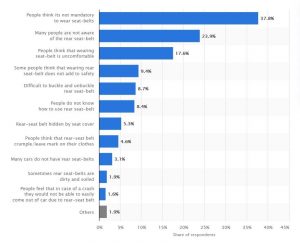Rear Seat Belt Use in India : A Look at Regulations, User Behaviour and Technical Solutions
Passenger safety is getting significant attention from car manufacturers as well as policy makers. In spite of all the efforts and penetration of technology, over 1.5 lakh people lose their lives in road crashes in India every year. Out of the total fatalities, over a quarter of those lives could have been saved, had the passengers worn their seat belts. (Stats for 2017, from a report by SaveLIFE foundation.) Digging further into the stats, with 17 deaths and 53 crashes every hour (source: MoRTH), the situation is unnerving. Seat belt usage varies between 14-43% among Road Traffic Injury victims. A lot of data input clearly proves that use of seat belts helps prevent injuries and dramatically bring down the fatalities during road accidents.
By reducing the velocity of the body due to sudden decrease in speed, seat belts help prevent injuries during a crash; distributing the force required to decelerate the passenger across their body further preventing from hitting the steering wheel or windshield at high speed.

Read about effects of not wearing a seat belt in our blog here.
A spotlight on Rear Seat Belts by Nissan-SaveLIFE Foundation
In 2019, Nissan partnered with SaveLIFE Foundation and commissioned a survey across 11 cities with over 6,300 respondents to bring into focus, the much-ignored rear-seat belts usage and awareness in India. The survey was acknowledged and released by the Minister for Road Transport & Highways.
Seat belts are known to be one of the most effective safety features to reduce fatalities in a road crash. The role of the rear seat belt in crash safety can never be overstressed. The study reveals that while most of the people surveyed were aware of the presence of rear seat belts in their vehicles, only a small portion of the population uses it. The rear seat belt is not worn by a majority (93%) of Indians, despite its presence; although over 70 percent of people were aware of the presence of rear seat belts, only 7% claimed to use it regularly. Most citizens are not aware of a law mandating the use of the rear seat belt. A total of one-fifth of all Indians choose to not wear rear seat belts in their cars due to discomfort and avoiding creasing or ruining their clothes. The study also found that over 90% of children who sit in the rear seat neither use a rear seat belt nor a child seat. (Source: Nissan-SaveLIFE foundation report)

Source: Study on Rear Seat Belt usage and child road safety in India, 11th January 2019
https://savelifefoundation.org/pdfs/Study-on-Rear-Seat-Belt-Usage-and-Child-Road-Safety-In-India.pdf
Seat Belt Regulations and Seat Belt Reminders in Rear Seats
Seat Belt Reminder (SBR) detects occupants in passenger and rear seats triggering a warning light and an audible chime reminding unbuckled passengers to fasten their seat belts. The additional benefit from mandating the incorporation of Seat Belt Reminder System depends upon the penetration and effectiveness of such systems into the current fleet. Beginning 2002, the Euro NCAP awarded points for front and rear seat belt reminder systems, when they were not required by any regulation. Later, in 2009, the Economic Commission for Europe (ECE) Regulation No. 16 required a seatbelt reminder system for the driver’s seat in all vehicles manufactured from 2011. Further recently in September 2019, ECE No. 16 was updated again to require a rear seat belt reminder. According to the Regulation, the seating position of the driver, the occupants of seats in the same row and all seating positions of the rear seat row(s) of M1 and N1 category vehicles shall be equipped with a seat belt reminder. This warning must consist of a visual indicator of any rear seating position in which the seat belt is unfastened as well as a visual and auditory change-of-status warning. Furthermore, the fitment of Seat Belt Reminders in all seat positions of M1 vehicles has been rewarded by Euro NCAP since 2009. Having a significant impact on the belt wearing rates, a large majority of other NCAP programs decided to introduce incentives for Seat Belt Reminder systems into their rating, successfully motivating the car makers worldwide to incorporate SBRs in an increasing number of vehicle models.
Since 1974, FMVSS 208 requires a seat belt warning system for the driver’s seat, and although not required formally by the FMVSS, a vast majority of vehicle manufacturers also equip the front passenger seat with such a system. However, not many vehicle manufactures extend this technology to the rear seats. In 2012, as part of the Moving Ahead for Progress, NHTSA was directed to initiate a rulemaking proceeding to amend the FMVSS 208 to require a rear ‘seat belt use warning system.’ Currently, NHTSA is continuing with this proceeding, most recently releasing an Advance Notice of Proposed Rulemaking (ANPRM) on the subject in September 2019.
In India, Front passenger Seat Belt Reminders were mandated for all cars from July 1, 2019 in India.
However, it is a also reality that an unrestrained passenger in the rear seat is equally or more vulnerable during a crash. Rear Seat Belt Reminder systems have proven to positively influence the belt wearing rates and save lives.
How effective can be an audio-visual reminder towards improving Seat Belt Wearing rates ?
A simple belt buckle monitoring of the rear seat only allows for visual information to the driver and optionally the rear seat passengers at vehicle start. A brief audible warning can only be triggered if a belted rear seat occupant unbuckles during the trip. The absence of a continuous audible alert limits the effectiveness of these systems. In 2012, a laboratory in Japan, compared the effects of various visual and audible SBR warnings on the belt wearing rates of rear seat passengers. When an optical warning was presented to the driver reminding the rear seat passengers, the initial belt wearing rate without SBR warning was 38%, the belt use increased to 56%, when both, driver and rear seat passengers were exposed to a visual warning, the usage rose to 72%. And when an audio-visual warning was used, 97% of the rear seat passengers buckled-up.
Occupant detection on the rear seat can be achieved in a similar way as on the front seat, by a pressure sensitive sensor, integrated between seat foam and trim activated by the occupant’s weight.
Seat belt reminders have proven to be effective in improving consumers use of seat belt thereby improving safety.
For any feedback or questions, you are most welcome to contact me at prashant@quanzen.com




